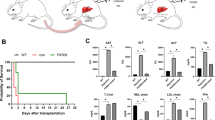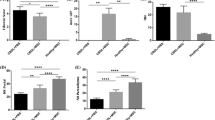Abstract
Objective
To investigate the mechanism of action of emodin for suppressing acute allograft rejection in a rat model of liver transplantation.
Methods
Brown Norway (BW) recipient rats of orthotopic liver transplantation (OLT) were divided into three groups, Group A receiving isografting (with BW rats as donor), Group B receiving allografting (with Lewis rats as donor), Group C receiving allografting and emodin treatment (50 mg/kg daily). They were sacrificed on day 7 of post-transplantation, and their hepatic histology, plasma cytokine levels, and T-cell subset expression were detected.
Results
Compared with those in Group A, rats: in Group B exhibited severe allograft rejection with a rejection activity index (RAI) of 7.67±0.98, extensive hepatocellular apoptosis with an apoptosis index (AI) of 35.83±2.32, and elevated plasma levels of interleukin-2 (IL-2), interleukin-10 (IL-10), tumor necrosis factor-α (TNF-α), CD4+ and CD4 CD4+/CD8+ ratio. However, recipients in Group C showed a decrease in histological grade of rejection and hepatocellular apoptosis, as well as a decrease in plasma levels of IL-2, TNF-α, CD4+ and CD4+/CD8+ ratio, but elevated levels of IL-10 as compared with the allograft group.
Conclusion
Post-OLT acute rejection could be attenuated by emodin, its mechanism of action may be associated with protecting hepatocytes from apoptosis, polarizing the Th 1 paradigm to Th2, and inhibiting the proliferation of CD4+ T cell in plasma.
Similar content being viewed by others
References
Keeffe EB. Liver transplantation: current status and novel approaches to liver replacement. Gastroenterology 2001; 120:749–762.
Encke J, Uhl W, Stremmel W, Sauer P. Immunosuppression and modulation in liver transplantation. Nephrol Dial Transplant 2004;19:22–25.
Casas-Melley AT, Falkenstein KP, Flynn LM, Ziegler VL, Dunn SP. Improvement in renal function and rejection control in pediatric liver transplant recipients with the introduction of sirolimus. Pediatr Transplant 2004;8:362–326.
Kuo YC, Tsai WJ, Meng HC, Chen WP, Yang LY, Lin CY. Immune reponses in human mesangial cells regulated by emodin from Polygonum hypoleucum Ohwi. Life Sci 2001;68:1271–1286.
Kuo YC, Meng HC, Tsai WJ. Regulation of cell proliferation, inflammatory cytokine production and calcium mobilization in primary human T lymphocytes by emodin from Polygonum hypoleucum Ohwi. Inflamm Res 2001;50:73–82.
Huang HC, Chang JH, Tung SF, Wu RT, Foegh ML, Chu SH. Immunosuppressive effect of emodin, a free radical generator. Eur J Pharmacol 1992;211:359–364.
Lin SZ, Xu XC, Tong HF, Yu YJ, You T. Inhibition of acute rejection of allogenic rat liver transplantation by emodin. Chin J Organ Transplant (Chin) 2007;28;147–149.
Kobayashi E, Kamada N, Goto S, Miyata M. Protocol for the technique of orthotopic liver transplantation in the rat. Microsurgery 1993;14:541–546.
Tsuchimoto S, Kusumoto K, Nakajima Y, Kakita A, Uchino J, Natori T, et al. Orthotopic liver transplantation in the rat. A simplified technique using the cuff method for suprahepatic vena cava anastomosis. Transplantation 1988;45:1153–1155.
Banff schema for grading liver allograft rejection: an international consensus document. Hepatology 1997;25:658–663.
Natori S, Selzner M, Valentino KL, Fritz LC, Srinivasan A, Clavien PA, et al. Apoptosis of sinusoidal endothelial cells occurs during liver preservation injury by a caspase-dependent mechanism. Transplantation 1999;68:89–96.
Sato M, Maulik G, Bagchi D, Das DK. Myocardial protection by protykin, a novel extract of trans-resveratrol and emodin. Free Radic Res 2000;32:135–144.
Lee HZ. Effects and mechanisms of emodin on cell death in human lung squamous cell carcinoma. Br J Pharmacol 2001;134:11–20.
Huang HC, Lee CR, Chao PD, Chen CC, Chu SH. Vasorelaxant effect of emodin, an anthraquinone from a Chinese herb. Eur J Pharmacol 1991;205:289–294.
Song E, Su F, Chen J, Ou Q, Wang M, Exton MS. Blocking CTL-based cytotoxic pathways reduces apoptosis of transplanted hepatocytes. J Surg Res 2001;99;61–69.
Song E, Chen J, Antus B, Su F, Wang M, Exton MS. Adenovirus-mediated Bcl-2 gene transfer inhibits apoptosis and promotes survival of allogeneic transplanted hepatocytes. Surgery 2001;130: 502–511.
Yamamoto H, Ohdan H, Shintaku S, Asahara T, Ito H, Dohi K. Role of the bcl-2/bax pathway in hepatocyte apoptosis during acute rejection after rat liver transplantation. Transplant Int 1998; 11:179–84.
Memon MA, DKarademir S, Shen J, Koukoulis G, Fabreg, F, Williams JW, et al. Seventh day syndrome-acute hepatocyte apoptosis associated with a unique syndrome of graft loss following liver transplantation. Liver 2001;21: 13–17.
Gras J, Wieers G, Vaerman JL, Truong DQ, Sokal E, Otte JB, et al. Early immunological monitoring after pediatric liver transplantation: cytokine immune deviation and graft acceptance in 40 recipients. Liver Transplant 2007;13:426–433.
Zhang AB, Zheng SS. Strong additive effect of calcitriol and cyclosporine A on lymphocyte proliferation in vitro and rat liver allotransplantations in vivo. Chin Med J 2006;119: 2090–2095.
Mosmann TR, Cherwinski H, Bond MW, Giedlin MA, Coffman RL. Two types of murine helper T cell clone. I. Definition according to profiles of lymphokine activities and secreted proteins. J Immunol 1986;136:2348–2357.
Strom TB, Roy-Chaudhury P, Manfro R, Zheng XX, Nickerson PW, Wood K, et al. The Th1/Th2 paradigm and the allograft response. Curr Opin Immunol 1996;8:688–693.
Nickerson P, Steurer W, Steiger J, Zheng X, Steele AW, Strom TB. Cytokines and the Th1/Th2 paradigm in transplantation. Curr Opin Immunol 1994;6:757–764.
Chen Y, Chen J, Liu Z, Liang S, Luan X, Long F, et al. Relationship between TH1/TH2 cytokines and immune tolerance in liver transplantation in rats. Transplantant Proc 2008;40:2691–2695.
Fung J, Kelly D, Kadry Z, Patel-Tom K, Eghtesad B. Immunosuppression in liver transplantation: beyond calcineurin inhibitors. Liver Transplant 2005;11:2267–80.
Fujimoto N, Ishida H, Nakamura I, Ogasawara K, Itoh Y. Quantities of interleukin-12p40 in mature CD8alpha negative dendritic cells correlate with strength of TCR signal and determine Th cell development. Microbiol Immunol 2003;47:1017–1024.
Author information
Authors and Affiliations
Corresponding author
Additional information
Supported by the National Natural Science Foundation of China (No. 30572395, No. 30973815).
Rights and permissions
About this article
Cite this article
Lin, Sz., Tong, Hf., Chen, Kj. et al. Effect of emodin in suppressing acute rejection following liver allograft transplantation in rats. Chin. J. Integr. Med. 16, 151–156 (2010). https://doi.org/10.1007/s11655-010-0151-7
Received:
Published:
Issue Date:
DOI: https://doi.org/10.1007/s11655-010-0151-7




